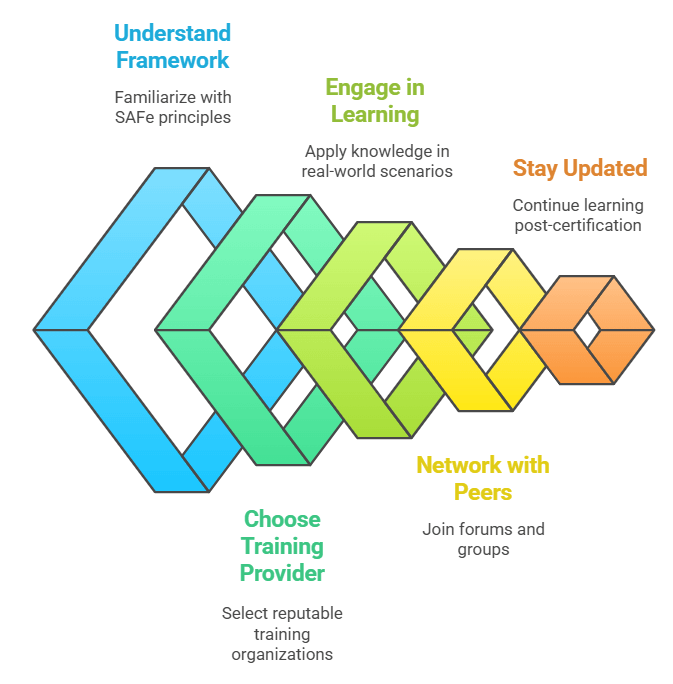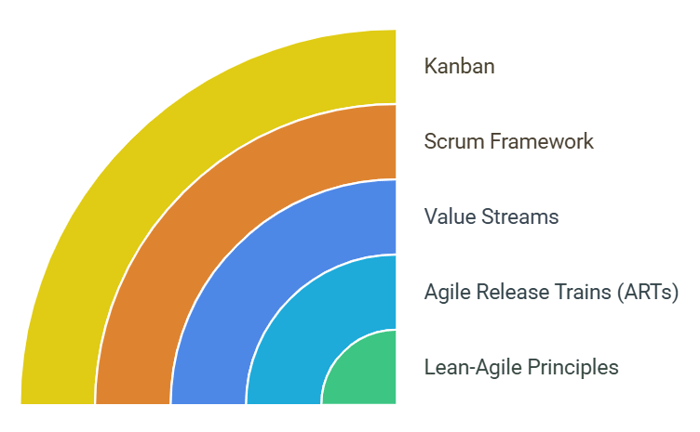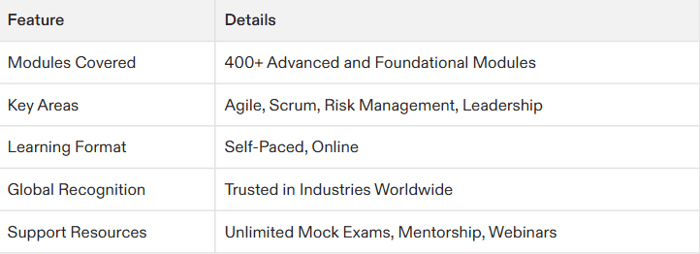Table of Contents
- What Is Safe Project Management Certification?
- Why SAFe Certifications Matter
- How to Get SAFe Certified
- Key Topics Covered in SAFe Certification Curriculum
- Deep Dive into SAFe Framework
- Less Commonly Known Facts About SAFe Certifications
- Tips for Pursuing SAFe Certification
- The Future of Project Management
- Role of AI in Project Management
- Importance of Continuous Learning
- Conclusion
- FAQs
Visualise you are the conductor of a big symphony orchestra, but instead of instruments, you are controlling teams, timelines and budgets. Welcome to the world of project management! Project management is not just a skill, it is a super power in the present business landscape. If you are looking to upgrade your skills, then you have come to the right place. So, without further ado, let’s get into the nitty gritty of what Safe Project Management Certification is all about and why you should care. In reality, it’s all about mastering the Scaled Agile Framework (SAFe) and other project management methodologies.
What Is Safe Project Management Certification?
The term "Safe Project Management Certification" seems to be a mix-up with SAFe certifications, which are designed to equip project managers with the tools and methodologies needed to manage projects efficiently and scalably. SAFe certifications focus on integrating project management principles into practical applications, emphasizing risk management, resource optimization, and outcome achievement. These certifications are particularly valuable as organizations worldwide prioritize risk management and error-proof methodologies in response to dynamic market demands.
Why SAFe Certifications Matter
In 2025, the workplace and projects are evolving at lightning speed. Here’s why SAFe certifications are your ultimate advantage:
Risk-Free Scaling: As businesses grow in size and complexity, risk increases exponentially. SAFe certifications help you identify potential pitfalls early and establish preventative measures.
Global Opportunities: Multinational corporations look for professionals with globally recognized credentials. SAFe certifications are evidence of your competencies and ability to handle high-stakes, cross-border projects with ease.
Career Growth: Data suggests that certified project managers earn more than their non-certified peers and are often the first choice for leadership roles where safety and reliability take precedence.
Mastering Agile at Scale: Agile methodologies are no longer limited to IT teams. The SAFe framework ensures that teams outside of IT are empowered with collaborative techniques, ensuring your value across all project verticals.
How to Get SAFe Certified
Earning a SAFe certification is a strategic process that involves several key steps. Here's a detailed guide on how to get certified:
Research Recognized Certifying Bodies
One of the most trusted sources for SAFe certifications is Scaled Agile, Inc. They offer a variety of certifications tailored to different roles and needs. When selecting a training provider, consider reputable organizations like KnowledgeHut or ValueX2 that offer comprehensive courses and resources. These providers ensure that you receive high-quality training and support throughout your certification journey.
For more information on SAFe training providers, you can visit the Scaled Agile website.
Complete the Training Program
Training is mandatory before sitting for the certification exam. SAFe training programs typically last between 2 to 5 days, depending on the provider and the specific certification. During this training, you'll gain in-depth knowledge of project management concepts, including:
Lean Principles: Understanding lean principles to eliminate waste and maximize value.
Agile Practices: Learning Agile methodologies and how they apply to large-scale projects.
Scaling Methods: Mastering the SAFe framework to scale Agile practices across your organization.
The training is usually conducted by a certified SPC (SAFe Program Consultant) who has real-life experience and excellent facilitation skills. This ensures that you not only learn the theoretical aspects but also gain practical insights into implementing SAFe in real-world scenarios.
Pass the Certification Exam
The certification exam is a critical step in obtaining your SAFe certification. The exam format varies depending on the certification type, but most are multiple-choice and timed. For example, the SAFe Agilist exam consists of 45 questions to be completed within 90 minutes. The exam tests your knowledge across multiple areas, including:
Strategy Alignment: Ensuring that projects align with organizational strategies.
Resource Optimization: Understanding how to optimize resources for efficient project delivery.
Effective Communication: Developing skills to communicate effectively across teams and stakeholders.
To prepare for the exam, it's advisable to review the course materials thoroughly and practice with mock exams. Many training providers offer additional resources like question banks and mock exams to help you prepare.
Renew Certification (When Required)
Most SAFe certifications require renewal every year to stay valid and current. This involves completing continuing education requirements, which ensure that you stay updated with the latest trends and practices in project management. Renewal is crucial for maintaining your professional edge and demonstrating your commitment to ongoing learning.
Key Topics Covered in SAFe Certification Curriculum
While every certifying body may differ slightly in structure, here’s a breakdown of the key topics frequently emphasized in SAFe certification courses:
Lean-Agile Principles: Understanding the core principles of lean-agile methodologies.
Agile Release Trains (ARTs): Implementing ARTs for better coordination and delivery.
Value Streams: Managing value streams to deliver customer-centric solutions.
Scrum Framework: Understanding Scrum roles and processes within SAFe.
Kanban: Applying Kanban principles for continuous flow and improvement.
Deep Dive into SAFe Framework
The SAFe framework is built around several core components:
Team Level: Focuses on Scrum teams and their roles within the larger framework.
Program Level: Involves Agile Release Trains (ARTs) for coordinating multiple teams.
Value Stream Level: Emphasizes managing value streams to align with business objectives.
Portfolio Level: Integrates lean portfolio management to align projects with strategic goals.
Less Commonly Known Facts About SAFe Certifications
SAFe Certifications Are Industry-Agnostic:
SAFe certifications are valuable across various industries, from IT and manufacturing to healthcare and finance.
Source: https://scaledagileframework.com/SAFe Framework Supports Multiple Roles:
SAFe offers certifications tailored to different roles, such as Scrum Master, Product Owner, and Release Train Engineer.
Source: https://www.scaledagile.com/certifications/SAFe Is Not Just for IT:
While SAFe originated in the IT sector, its principles are now applied across multiple industries.
Source: https://www.scaledagileframework.com/about/SAFe Certifications Enhance Career Flexibility:
With a SAFe certification, you can transition between roles or industries more easily.
Source: https://www.scaledagile.com/why-safe/SAFe Framework Emphasizes Continuous Learning:
SAFe certifications require periodic renewal, ensuring you stay updated with the latest practices.
Source: https://www.scaledagile.com/certifications/SAFe Supports Large-Scale Agile Implementations:
SAFe is designed to scale agile practices across entire organizations.
Source: https://scaledagileframework.com/safe-implementation-roadmap/SAFe Certifications Are Globally Recognized:
SAFe certifications are respected worldwide, making them a valuable asset for international projects.
Source: https://www.scaledagile.com/why-safe/SAFe Framework Integrates Lean Portfolio Management:
SAFe includes lean portfolio management to align projects with strategic objectives.
Source: https://scaledagileframework.com/lean-portfolio-management/SAFe Certifications Offer a Competitive Salary Advantage:
Certified project managers typically earn higher salaries than their non-certified peers.
Source: https://resources.scaledagile.com/ebooks-guidesSAFe Supports Team Collaboration:
SAFe emphasizes team collaboration and alignment across departments.
Source: https://www.scaledagileframework.com/

Tips for Pursuing SAFe Certification
Understand the Framework: Familiarize yourself with SAFe principles, as they are central to the certification.
Choose the Right Training Provider: Opt for reputable organizations like KnowledgeHut or ValueX2 that offer comprehensive modules and resources.
Engage in Practical Learning: Apply what you learn in real-world scenarios to better grasp the concepts and methodologies.
Network with Peers: Join forums and groups of fellow project managers to share insights and experiences.
Stay Updated: Project management trends evolve, so keep learning even after certification to maintain your edge.
The Future of Project Management
As we move forward into 2025 and beyond, project management will continue to evolve. The integration of AI, machine learning, and other technologies will change how projects are managed. However, the core principles of effective project management—such as risk management, team collaboration, and strategic planning—will remain essential.
Role of AI in Project Management
AI is increasingly being used in project management to automate tasks, predict outcomes, and enhance decision-making. Tools like project management software with AI capabilities can help in resource allocation, scheduling, and risk analysis. However, while AI can streamline processes, human judgment and leadership are still crucial for successful project delivery.
Importance of Continuous Learning
In today's fast-paced environment, continuous learning is vital for project managers. Staying updated with the latest methodologies, technologies, and best practices ensures that you remain competitive and effective in your role.
Conclusion
Becoming certified in SAFe or other project management methodologies is not just a personal achievement—it provides actionable value to your organization and opens doors to incredible career growth opportunities. Make the leap today and explore training pathways through trusted platforms. If you're interested in a broader range of project management certifications, such as the PMP, check out our comprehensive prep course at https://app.apmic.org/pages/project-management-certification.
FAQs
What is the duration of the SAFe certification process?
The training typically lasts anywhere between 2-5 days, depending on the provider and your learning pace. The exam preparation can take additional time.
Do I need prior project management experience for SAFe certifications?
While prior experience is beneficial, many SAFe certifications are designed to accommodate beginners by starting with foundational concepts.
How much does SAFe certification cost?
The cost varies between $1,000 and $3,000, depending on the certifying body and the training resources offered.
Is renewal mandatory after gaining SAFe certification?
Yes, most SAFe certifications require renewal every year to stay valid and current.
Can I prepare for the SAFe certification exam online?
Absolutely! Many training resources offer robust online programs that you can complete from the comfort of your home.
What industries value SAFe certifications?
From IT and manufacturing to healthcare, finance, and construction, virtually every industry looks for SAFe skills.
What are the prerequisites for enrolling in a SAFe certification course?
While prerequisites vary, most courses recommend a basic understanding of project management principles. Some advanced courses may require prior certifications.
What is the format of the SAFe certification exam?
The exam typically includes multiple-choice questions, case studies, and scenario-based questions to test practical knowledge and application.







